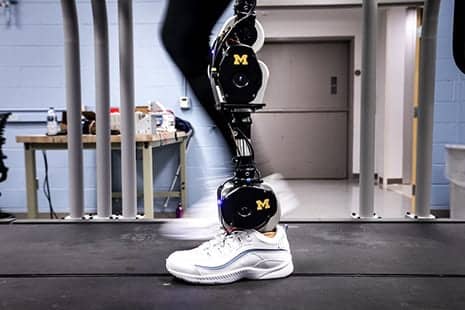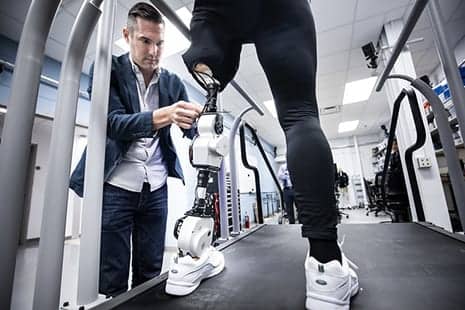A new open-source, artificially intelligent prosthetic leg designed by University of Michigan and Shirley Ryan AbilityLab researchers is now available to the scientific community.
The leg’s free-to-copy design and programming are intended to improve the quality of life of patients and accelerate scientific advances by offering a unified platform to fragmented research efforts across the field of bionics.
Details on where to order the parts, how to put them together, and how to program the leg are now available at opensourceleg.com.
“Our Open Source Bionic Leg will enable investigators to efficiently solve challenges associated with controlling bionic legs across a range of activities in the lab and out in the community,” says lead designer Elliott Rouse, core faculty at U-M’s Robotics Institute and professor of mechanical engineering, in a media release.
“In addition, we hope our bionic leg will unite researchers with a common hardware platform, and enable new investigators from related fields to develop innovative control strategies.”
Rouse and collaborator Levi Hargrove, director of the Center for Bionic Medicine at the Shirley Ryan AbilityLab, a research hospital in Chicago, unveiled the leg and its online platform recently at the Amazon re:MARS conference in Las Vegas.
Hargrove, also an associate professor of physical medicine and rehabilitation and biomedical engineering at Northwestern University, is already using the leg in clinical studies, he notes in the release.
“While the designs and code are free, the leg is still a high-end, state-of-the-art machine,” he adds. “It’s a unique plug-and-play system that allows scientists to avoid research and development costs in the millions of dollars and immediately begin testing on prosthetics for the knee and ankle. It effectively lowers the barriers to entry for researchers.
The prosthetic features advanced AI-based control, led by Hargrove, that can automatically adapt the actions of the bionic leg to seamlessly switch activities, such as going from walking, to going up stairs, to down a ramp. To accomplish this, the team uses a combination of muscle contraction signals and sensor data from within the bionic leg to predict whatever behavior is required for the next step.
A video from Shirley Ryan AbilityLab features a patient testing the technology.
As an open source project, anyone can contribute to improving the leg’s design and function. While the leg is meant as a research tool and not as a build-at-home solution, patients involved in the project can help focus and improve the design through their feedback in trials.
Companies can prototype the leg with their own parts to enhance the design. And, researchers can utilize the project website to discuss modifications and suggestions in design and control, the release continues.
“This represents the future of research?,” Rouse comments, “rapid prototyping of open source robotic hardware and embedded systems with shared code.”
The team is now partnering with groups nationally and internationally in developing and testing the leg, including Carnegie Mellon University, the University of Texas at Dallas, Georgia Tech, VA Puget Sound and University of Washington, and the University of Sydney.
The project is supported by the National Science Foundation’s National Robotics Initiative and the MLS Renewed Hope Foundation.
[Source: Shirley Ryan AbilityLab]






